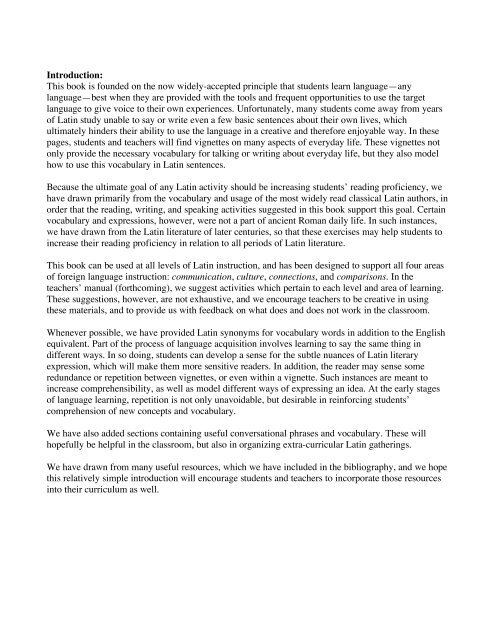Colloquia Cottidiana - John P. Piazza, MA
Colloquia Cottidiana - John P. Piazza, MA
Colloquia Cottidiana - John P. Piazza, MA
You also want an ePaper? Increase the reach of your titles
YUMPU automatically turns print PDFs into web optimized ePapers that Google loves.
Introduction:<br />
This book is founded on the now widely-accepted principle that students learn language—any<br />
language—best when they are provided with the tools and frequent opportunities to use the target<br />
language to give voice to their own experiences. Unfortunately, many students come away from years<br />
of Latin study unable to say or write even a few basic sentences about their own lives, which<br />
ultimately hinders their ability to use the language in a creative and therefore enjoyable way. In these<br />
pages, students and teachers will find vignettes on many aspects of everyday life. These vignettes not<br />
only provide the necessary vocabulary for talking or writing about everyday life, but they also model<br />
how to use this vocabulary in Latin sentences.<br />
Because the ultimate goal of any Latin activity should be increasing students’ reading proficiency, we<br />
have drawn primarily from the vocabulary and usage of the most widely read classical Latin authors, in<br />
order that the reading, writing, and speaking activities suggested in this book support this goal. Certain<br />
vocabulary and expressions, however, were not a part of ancient Roman daily life. In such instances,<br />
we have drawn from the Latin literature of later centuries, so that these exercises may help students to<br />
increase their reading proficiency in relation to all periods of Latin literature.<br />
This book can be used at all levels of Latin instruction, and has been designed to support all four areas<br />
of foreign language instruction: communication, culture, connections, and comparisons. In the<br />
teachers’ manual (forthcoming), we suggest activities which pertain to each level and area of learning.<br />
These suggestions, however, are not exhaustive, and we encourage teachers to be creative in using<br />
these materials, and to provide us with feedback on what does and does not work in the classroom.<br />
Whenever possible, we have provided Latin synonyms for vocabulary words in addition to the English<br />
equivalent. Part of the process of language acquisition involves learning to say the same thing in<br />
different ways. In so doing, students can develop a sense for the subtle nuances of Latin literary<br />
expression, which will make them more sensitive readers. In addition, the reader may sense some<br />
redundance or repetition between vignettes, or even within a vignette. Such instances are meant to<br />
increase comprehensibility, as well as model different ways of expressing an idea. At the early stages<br />
of language learning, repetition is not only unavoidable, but desirable in reinforcing students’<br />
comprehension of new concepts and vocabulary.<br />
We have also added sections containing useful conversational phrases and vocabulary. These will<br />
hopefully be helpful in the classroom, but also in organizing extra-curricular Latin gatherings.<br />
We have drawn from many useful resources, which we have included in the bibliography, and we hope<br />
this relatively simple introduction will encourage students and teachers to incorporate those resources<br />
into their curriculum as well.


